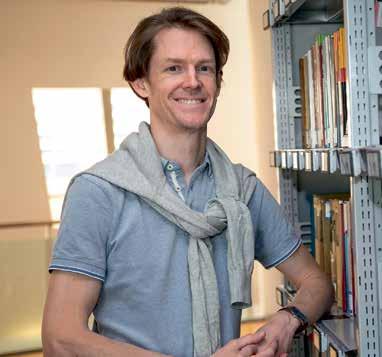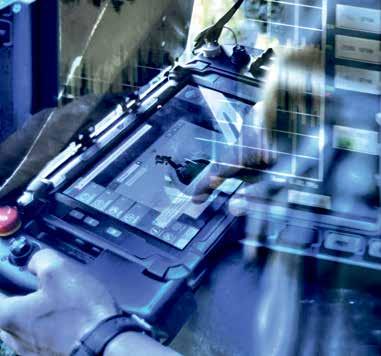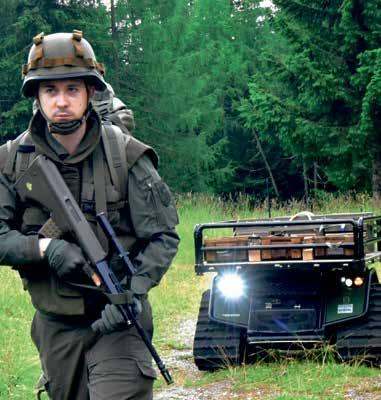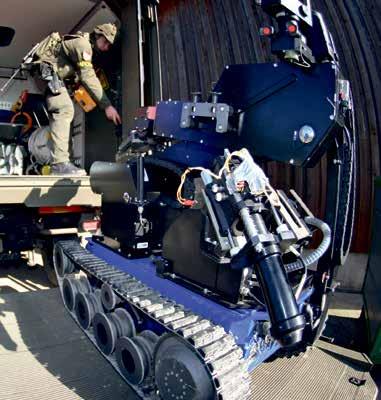
8 minute read
Austria’s 6G research is state-of-the-art in every way
by medianet
search institutions in the field of mobile communications and communications engineering is working on the technical feasibility of 6G. Austrian companies Technikon Forschungs- und Planungsgesellschaft mbH (as coordinator) and NXP Semiconductors Austria as well as the Institute of Signal Processing and Speech Communication at Graz University of Technology (TU Graz) are substantially involved.
“The world is becoming more and more interconnected. More and more data has to be transmitted, received and processed by a growing number of wireless devices – data throughput is consistently on the rise. In the Horizon2020 project REINDEER, we are devoting ourselves to these developments and investigating a concept with which data transmission in real time can be scaled practically to infinity,” says TU Graz researcher Klaus Witrisal, an expert in wireless communication technology.
Advertisement
Antennas as wall tile or wallpaper
The type of antennas for data transfer has to change; maybe antennas could be wall tiles or wallpapers. How is this supposed to work? Witrisal explains the approach: “We want to develop what we call RadioWeaves technology – a kind of antenna fabric that can be installed in any location of any size – for example, in the form of wall tiles or wallpaper. So entire wall surfaces can act as antenna radiators.”
With previous radio standards such as UMTS, LTE and currently 5G, signals are transmitted via base stations – i.e. antenna infrastructures that are permanently located at a specific position. The denser the network of fixed infrastructure, the
Horizon2020-Projekt REINDEER
Transferring more data even faster – that is the aim of the new antenna technology developed by the project REINDEER (REsilient INteractive applications through hyper Diversity in Energy Efficient RadioWeaves technology). It is funded by the EU Horizon2020 programme with a total of 4.6 million euros. 600,000 euros of this amount will go to Graz University of Technology (TU Graz), where the project is located in the Field of Expertise Information, Communication & Computing, one of the University‘s five main research areas. https://reindeer-project.eu/
© SAL
Thomas Lüftner and Pedro Julian have joined forces.
higher the throughput (i.e. the amount of data that can be transmitted and processed in a given time window). However, the base stations are a bottleneck. The more wireless devices there are connected to a base station, the more unstable and slower the data transmission. With RadioWeaves technology, that bottleneck would disappear “because instead of a single access point, we can hook in as many access points as we want,” says Witrisal.
Real-time inventory and grandiose stadium experience
Witrisal says that the technology is not needed for the private home. But for industrial and public facilities, it holds opportuni-
Project partners:
c Technikon (lead partner, Austria) c NXP Semiconductors Austria (Austria) c TU Graz (Austria) c BlooLoc NV (Belgium) c Ericsson (Sweden) c KU Leuven (Belgium) c Linkopings Universitet (Sweden) c Lunds Universitet (Sweden) c Telefónica Investigacion Y Desarrollo SA (Spain)

ties that go far beyond 5G networks. “If 80,000 people in a sports stadium, all equipped with virtual reality goggles, want to watch the decisive goal simultaneously from the perspective of the goal scorer, this will be possible in the future with a RadioWeaves antenna fabric.” The radio waves would also provide wireless power to the VR goggles. In industrial halls, the technology could provide unprecedented coverage. It would be feasible to locate thousands of objects in real time.
In general, Witrisal sees great opportunities for radio-based positioning technology – a research focus of his working group at TU Graz. The researchers believe that the RadioWeaves technology can be used to locate goods with an accuracy of ten centimetres. “This allows three-dimensional models of goods flows to be realised: for production and logistics through to augmented reality on the sales floor.”
The research project started in January 2021. By 2024, the consortium aims to develop the first hardware demonstrator to experimentally validate the RadioWeaves technology. Witrisal: “6G won’t officially be ready until the end of this decade – but when it is, we want to make sure that high-speed wireless access is where we need it, when we need it.” ◆

© TU Graz/Robert Frankl
“Our Army” – innovative – researching – securing the future
How the Austrian Armed Forces are using a wide variety of measures and a multitude of projects to strengthen Austria as a location for innovation.
Research and development have a long tradition in the Austrian Armed Forces. The National Defence Research Programme FORTE and the European Defence Fund (EDF) provide a fresh and additional impetus in this field of research and, in the long term, can also help to strengthen Austria’s position as a centre of knowledge and technology in the European competition for innovations.
In 2008, the research and development activities of the Austrian Armed Forces were evaluated and put on a new footing. Since then, the responsible department “Research and Armament Policy” of the Federal Ministry of Defence has been in charge of the corresponding research-related agendas of the Austrian Armed Forces on a national and international level. It contributes, among other things, to developing the capabilities of the Austrian Armed Forces. Through close contact to the most important university and non-university research institutions, to committees such as the Austrian Science Council and the Ministry’s own Science Commission, but also to the industrial sector, the department constantly monitors and evaluates the latest developments. The Armed Forces also implements internally future-oriented research and development in a large number of projects with other departments in the defence sector, such as the Office of Armament and Defence Technology, the Cyber Security Centre, the National Defence Academy and the Theresian Military Academy.
Research as a strategic factor
Research represents a central factor for the Austrian Armed Forces. It is not only a driver of the organisation’s innovative capacity, but also the necessary and important basis for the development of the armed forces and their capabilities. The research that is indispensable in this context follows a holistic approach and takes place not only in the technological field, but also in social sciences, liberal arts and cultural sciences. In doing so, research must face the challenges of the future in a specific manner to ensure that the armed forces can act as Austria’s

Facts & Figures*
Professional soldiers: 15,456 thereof female soldier: 642 Civilian employees: 7.623 Soldiers on foreign missions: ~1,000 Conscripts: 6,264 2021 budget of the Ministry of Defence in mln euros : 2,522.393
* as of 1 May 2021
Federal Ministry of Defence (BMLV)
Roßauer Lände 1, 1090 Vienna Tel: +43(0)50201-0 buergerservice@bmlv.gv.at www.bundesheer.at
Key technologies Defence Technology 2030
c Artificial intelligence
c Autonomous systems
c Quantum technology
c Space technology
c Biotechnology
c Human enhancement / augmentation /
modulation
c Materials science & nanotechnology
c Neuroscience
BMLV/Guenter Wilfinger ©

© Beganovic Amir © BMLV

Cutting-edge technology at the Austrian Armed Forces: The remote-controlled bomb disposal robot „Theodor“ in action and a self-propelled transport robot in trials.
“strategic reserve” along their entire range of tasks. This includes not only recognising emergent technological developments and trends in due time, but also making future key technologies usable for the armed forces.
Promoting the business location – initiating strategic developments
In the national environment, the Austrian Armed Forces have at their disposal, among others, the security research programme KIRAS and the defence research programme FORTE for security from all sides. While FORTE focuses on the field of defence technology in support of military mission fulfilment, KIRAS follows the dual-use approach and represents the civilian component in the national research environment. However, the national research funding programmes are not only aimed at providing public-sector users such as ministries, authorities, regional governments etc. with access to targeted research results. They are also intended to prepare the Austrian industrial base for collaborations on an international level and thus strengthen Austria as a business location as well as strengthen the competitiveness of Austrian companies in the international environment.
At the European level, the European Defence Fund (EDF) was established to strengthen the innovative, industrial and scientific base of the European defence industry and to make a decisive contribution to the strategic autonomy of the EU. In the period 2021 to 2027, the EDF will support research and development projects dealing with current defence issues and new security threats with a total of 7.9 billion euros. This is intended to trigger strategic developments in selected industrial sectors and to achieve a better strategic positioning of Austrian companies in the European environment.
A strong and reliable partner for the future
During numerous projects and undertakings in the national and international environment, the Austrian Armed Forces have been able to establish themselves as a strong and reliable partner for the Austrian economy and industry. In the last five years alone, about 300 projects have been implemented and about 200 partners from research, business and industry have had access to about 90 million euros in funding in this area. In addition, significant technological advances and innovative solutions have been implemented for the Austrian Armed Forces. The close cooperation between the Austrian Armed Forces and its partners will continue to be both an opportunity and a challenge in the future, because of highly dynamic developments, for example in the areas of digitisation, sustainability and hybrid threats. They require rapid, flexible and innovative solutions for future-proof Austrian Armed Forces and thus for a future-proof Austria.










